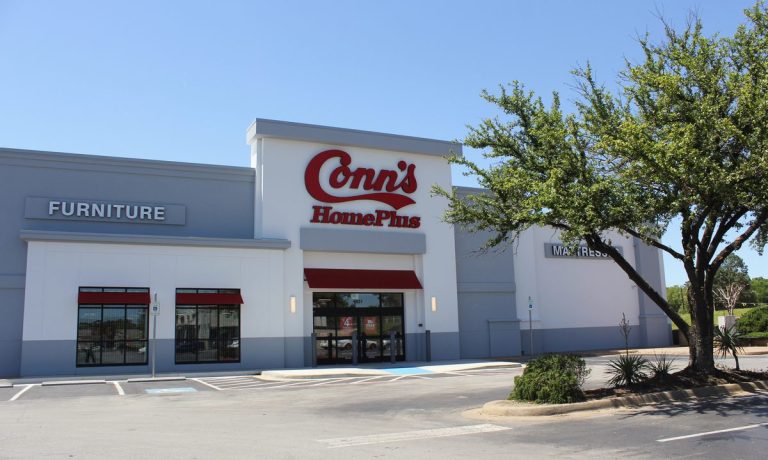
It’s been 11 months since Chandra Holt was appointed CEO of Conn’s and just six months since the furniture, appliance, and electronics retailer unveiled what she calls “our big, hairy, audacious goal” of becoming a multibillion-dollar omnichannel business by 2025.
And yet, for all that action and ambition, this chain of 160 stores that dot the sunbelt from Virginia to Nevada has chosen a path forward that is directly tied to its 130-year-old roots.
“When you think about our history at Conn’s it’s all about providing access to our financing and high-quality goods to people who couldn’t get the financing elsewhere,” Holt said in a recent conversation with PYMNTS Editor-in-Chief Matt Nesto, before instinctively pivoting to the company’s tag line — “because everyone deserves a home they love.”
Although Conn’s stores may look similar to many of its larger rivals and also carry many of the same products, its business model and customer base are distinctly different.
For starters, Holt said, “we over-index in customers that have subprime FICO scores,” noting that Conn’s in-house financing currently accounts for 50% of the total business, while 6 in 10 of its shoppers are what she calls “financial access customers.”
“They come to us because they can get financing with Conn’s that they can’t get anywhere else” she said. “Payments have been a cornerstone of our differentiation for a very long time.”
A Payments-Based Path
As Holt puts it, “Conn’s vision is to have a payment option for everyone,” including offering everything from traditional branded credit cards and installment loans to its newly acquired lease-to-own assets, BNPL plans — and most recently the addition “old-school layaway plans.”
“We’ve been doing buy now, pay later with our own financing for a long time, so we challenged ourselves; ‘How can we make sure we have a payment option for anyone who walks into Conn’s, no matter what their credit rating is?’ and so we actually recently launched old-school layaway,” Holt said, noting plans to offer the traditional layaway plan nationally in Q3 after a successful pilot program earlier this year.
While most retailers lack the space and capacity to store bulky merchandise for customers and are much more geared toward digital solutions like BNPL, Holt said Conn’s is different, in that the company has built an “extremely fast supply chain” that can hold all of its inventory in an outsized network of 11 distribution centers and 20 cross dock locations that serve 150 stores in 15 states.
Fighting Headwinds and Other Challenges
To be sure, Holt’s tenure at Conn’s has not been without its challenges, as its stock price has slumped 65% in the past year at a time when the entire retail industry is facing an unprecdented mix of macroeconomic headwinds.
“Unfortunately, these [headwinds] are all happening at the same time, but they’re all also cyclical, and I think they’re near-term things that will normalize over time,” Holt said, noting that the brand is in a unique position even if the economy slows down.
“FICO scores have been raising over over time for the last probably five plus years and so if we do get into a recessionary period, FICO scores will come down and so the pie that we kind of play in naturally will become bigger and that will actually benefit us going forward,” she said.
Other initiatives Holt is pursuing under the three-year growth plan include further expansion of the brand’s geographic footprint, doubling revenues to at least $2 billion, and increasing eCommerce revenues to 20% of total sales from less than 6% when she arrived.
That latter stat, and an online conversion rate that was at just 0.25% is of particular concern to Holt who came to run the greater-Houston based retailer after serving as the CMO of Walmart.com, as well as stints at Sam’s Club, Target and Walgreens over the past 20 years.
“What we’re really trying to tackle is getting that conversion rate up,” Holt said, adding that half of the upside will come from assortment and pricing, another 25% from investments to enable a better tech experience and platform migration, with the final 25% of improvement coming from increased awareness of the company’s 90% in-stock average and rapid delivery service.
“Just becoming famous for that next day white glove delivery [will help],” Holt said, pointing to the competitive advantage of not having to tell customers it will be two to four weeks — or more — to replace a broken refrigerator.
Belk Partnership
Finally, Holt said there’s significant upside in the store-in-store partnership with Belk that it announced last month that will begin with a 20-location pilot and e-commerce roll out in the fall, followed by a still-to-be-revealed rebrand of its own stores in 2023.
While some analysts had questioned the overlap and cannibalization risk in markets where Belk and Conn’s both have stores, Holt said the pact will be highly incremental since the two retailers have distinctly different customers.
“When you look at other retailers that have a high amount of these ‘fast reliable’ customers [who value delivery and availability over financing access], department stores pop up,” she said. “The FICO scores of their customers are much different than the profile of our customers and so going into a Belk — or another department store — gives us access to customers that are very different from the customers that are walking into our own Conn’s stores,” she added, predicting that Belk shoppers will come to find Conn’s speed and convenience appealing.